Cartoonist Larry Pickering blurred the line
Known for inflammatory images often with lewd sexual overtones, Larry Pickering’s life was as colourful as his bawdy etchings.

It was a time before political correctness got its sharp claws into cartoonists and political debate generally, the politicians themselves were larger than life and had a sense of humour, and calendars featuring outrageous drawings of naked pollies would sell gangbusters off the newsagents’ shelves.
That was the 1970s, when cartoonist Larry Pickering was at his height, drawing inflammatory images often with lewd sexual overtones, and not just getting away with it but increasingly famous and well-off by it.
One cartoon from 1977, when Pickering was a staff cartoonist on this newspaper, displayed a prim pyjama-clad prime minister Malcolm Fraser in a big double bed with sacked PM Gough Whitlam, who had by then returned to opposition, looking a bit beaten up with a black eye and sticking plasters.
“Gough, I think I’m getting another election,” says Fraser, to which Whitlam, holding one hand up defensively and gripping his head with the other, replies: “Oh, Gawd, Malcolm — not again!”
Pickering, who died on Monday night aged 76, after a battle with cancer, became mired in controversy over allegedly shonky business dealings in which it is claimed he defrauded a lot of people, and also for taking the balance of being provocative too far into the realm of vulgar obscenity.
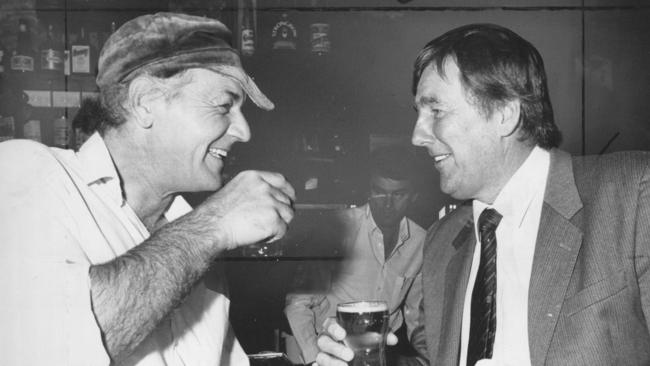
But in his day he was the undisputed doyen of the political cartoonists.
“At the time of the Whitlam dismissal, he was the right person, in the right job, at the right time,” cartoonist Warren Brown says.
“Of his era, he was certainly the most famous cartoonist.”
The nude politician calendars were one of a variety of entrepreneurial ventures Pickering got going.
Brown says: “You just couldn’t do it now — that was a pretty risque thing to do in the 70s, but he got away with it, and a lot of people loved it.’’
Brown, in a bizarre quirk of history, was talent-spotted by Pickering at the age of 16, or so it seemed: the Commonwealth Bank ran a competition for children to draw cartoons and submit them, and the best, selected by Pickering, were produced in a book, Cartoons by Australian Kids. Brown’s cartoon was one of them.
But Brown does not think for a moment that Pickering was motivated by kind, philanthropic sentiments to give young aspiring cartoonists a chance.
“I am suspecting there was some sort of a scam in it, because he didn’t operate any other way.”
In fact, as fellow cartoonist Eric Lobbecke remembers it, entrants had to pay Pickering about $20 to get in the book but, as it was his first published cartoon at the age of about 14, Lobbecke regarded it as money well spent.
Lobbecke says he loved Pickering during his heyday: “He gave us a lot of iconic figures, like the Aussie being the guy with the can in his hand with a singlet on and the corked hats.”
Pickering had been both Lobbecke’s and Brown’s hero as kids, but for Brown at least it didn’t last long.
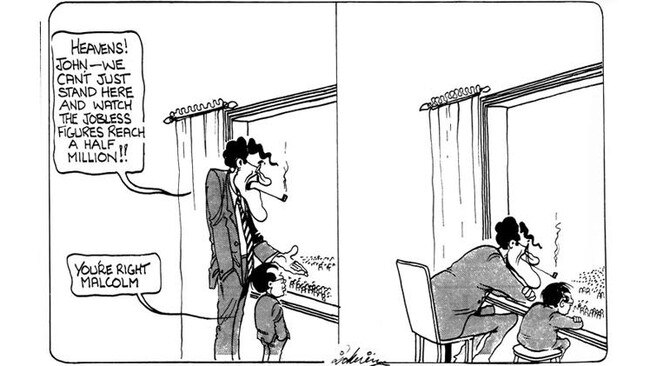
“In his day he was a terrific cartoonist, but he was a pretty horrible guy,” Brown says.
In 2012, A Current Affair packed an extraordinary number of allegations of serious wrongdoing and general acts of sleaziness by Pickering into a segment of only four minutes and 56 seconds.
The program featured a woman who was a former partner claiming Pickering had failed to pay child support while insisting he had no money — at a time when he was swanning around in an Aston Martin and living in a penthouse.
He had allegedly set up one scam to sell useless betting software, which claimed to predict the outcome of horse races and lost a lot of people a lot of money, and another scheme he allegedly sold under an alias, which ripped off others through a bogus company in Hong Kong.
In standard ACA style, when a reporter shouted questions at Pickering over the front gate and through the screen front door, he said it was all “bullshit” and he had “nothing at all to do with it”.
There was one grab from Pickering, however, from an earlier interview that was more nuanced, reflecting how he clearly regarded his conduct as acceptable in that era.
“I may have been what they call a scammer in the past, but I thought I had a legitimate product,” Pickering says in the footage.
His career as a scammer was only one of a wide number of enterprises Pickering enjoyed: others including tomato growing, and investing in a racehorse which came second in the Melbourne Cup in the mid-1980s.
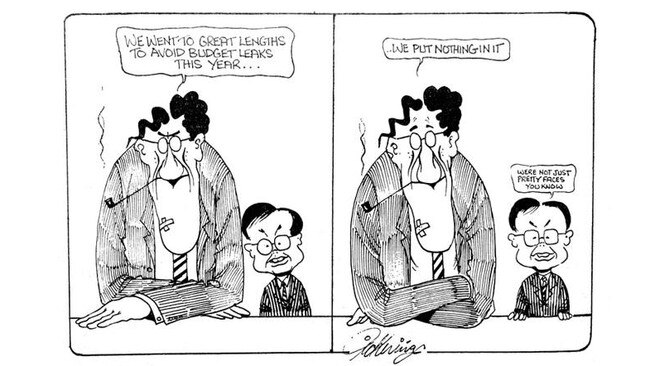
By that stage, Pickering had ensconced himself on the Gold Coast and, as fellow cartoonist and contemporary Patrick Cook observed, “it was an intersection in business interests that could only happen in Queensland”.
Lawrence Pickering was born on October 18, 1942, to Edgar and Phyllis Pickering, and grew up in Greensborough, northeast of Melbourne.
The son of strict Christadelphian parents, he reportedly refused to be baptised at age 14 and was kicked out of home.
He then began work as a labourer for the Victorian Railways, by faking his age.
While employed as a proofreader for The Canberra Times, Pickering began displaying his cartoon drawings on the walls of the men’s toilets until 1971; the editor took sufficient note that he took them off the walls and started publishing them in the paper.
Soon, Pickering won a Walkley Award, Australian journalism’s most-coveted prize, for best cartoon.
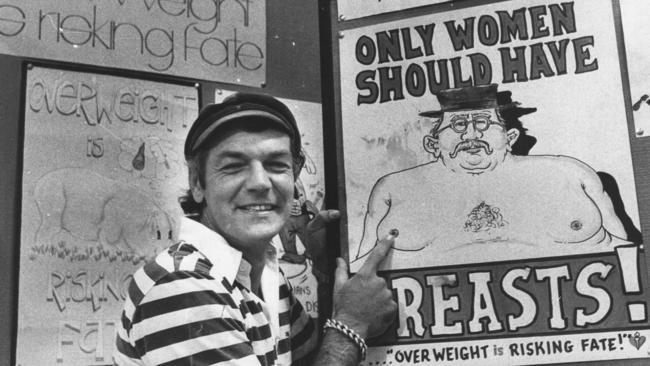
He achieved that feat for four consecutive years as he moved to The Sydney Morning Herald and The National Times. He worked for The Australian for five years before leaving full-time cartooning in 1981.
Cook took over from Pickering as cartoonist on The National Times in the mid-1970s, which he says was a vibrant time for the trade.
“It was definitely a time of the outrageous,” Cook says. “In the times of the 70s and 80s, there was a certain frisson.”
When a cartoonist concocted a particularly offensive rendition of a public figure, Cook says, “in those olden days a great many politicians would come out and ask for the original”.
Cook says Pickering, who he knew socially as a lot of fun, had always held the view that he would have a riot of a time as a cartoonist, and then move on.
“His idea was 10 years to get there, and 10 years to stay there, and then time to bugger off.”
His success, Cook says, was in not taking the subject matter too seriously.
“He was never known to be highbrow about the issues of the day. He was looking for the imp in the story,’’ Cook says.
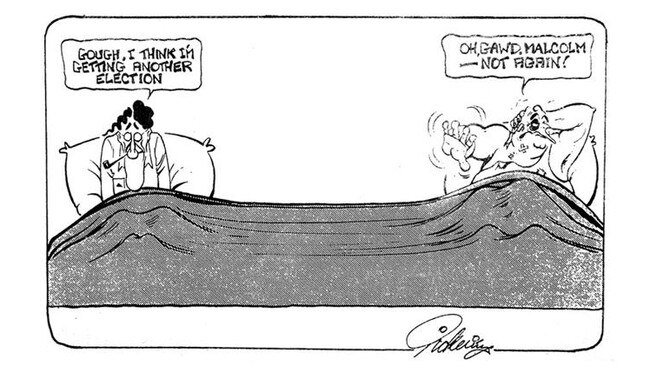
“Larry brought such glee to what he did. He was wonderful.”
Pickering pursued projects including horse racing and, in a bid to fulfil his childhood dream of winning the Melbourne Cup, he bought a yearling for a mere $7000.
The horse’s name was Rising Fear, but it was known in the stables as Tojo, and it quickly became popular after winning a string of Sydney races.
Confident that the horse could win the Melbourne Cup, Pickering began training him to pick up a replica of the Cup with his teeth, place it on a table, and bow.
After two years of training, he believed he was ready for the 1986 Melbourne Cup. At the 400m mark of the race, ridden by jockey Bob Skelton, Rising Fear led by three lengths until he was overtaken by At Talaq.
One of Pickering’s friends, advertising guru and horse owner John Singleton, was once quoted as saying that rather than teach Rising Fear to bow to the crowd, “if he’d spent one more day training the f..king thing we might have won the race’’. According to friend and fellow cartoonist Paul Zanetti, it was a pattern with Pickering.
“He just kept getting these unfortunate hits all the time,” Zanetti says.
“He also had a tomato farm and they were just about to harvest. A hailstorm wiped out a $3 million crop.”
Right through his later years, up until his death, Pickering kept and practised an interest in cartooning and political commentary, using as the platform his blog, the Pickering Post.
Critics — and there are plenty of them — say Pickering’s posts and cartoons on the blog became progressively ultra-right-wing, misogynist, homophobic and in some cases just plain revolting.
He drew and ran cartoons of Julia Gillard that were extreme in their vulgarity and sexual coarseness.
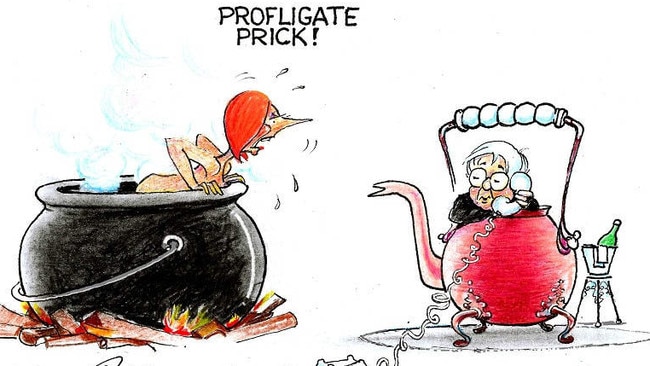
He was placed under police protection in 2015 after posting on his website a cartoon of the prophet Mohammed on a spit roast and skewered by a pencil.
Comments made by Pickering at a Q Society fundraising dinner earned him public ire last year.
“Let’s be honest, I can’t stand Muslims,” he said. “If they are in the same street as me, I start shaking.”
Supporters such as Zanetti defended Pickering and the blog as — as he put it — a haven for the disenfranchised.
“So many of these online platforms are so politically correct and his blog was the destination for so many people who felt they had nowhere else to go.”
Pickering was diagnosed with cancer in 2016 and was told he had just months to live.
He kept up the fight for two years, while still blogging on the Pickering Post as recently as last month.
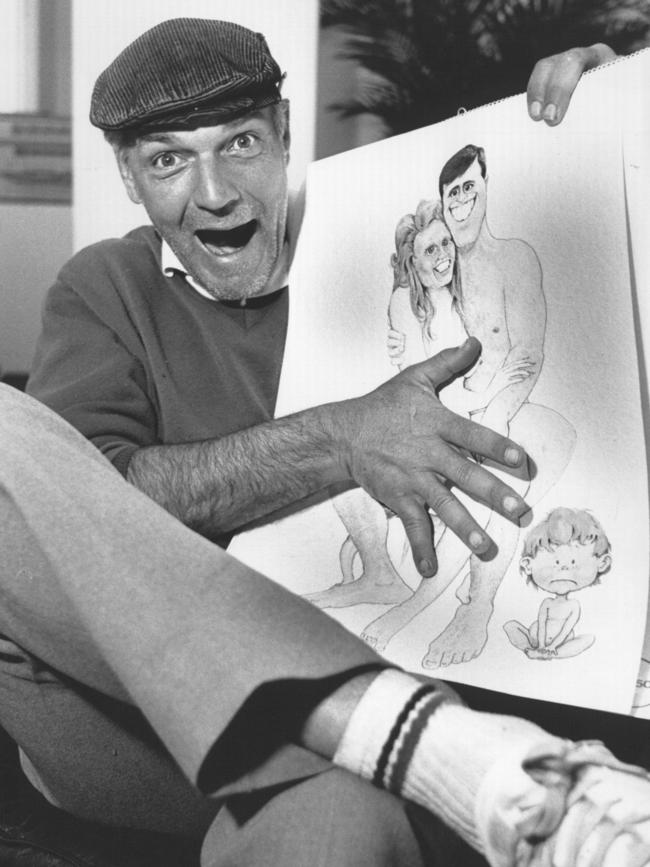
His take on the Wentworth by-election was certainly unique, attacking the mainstream commentariat for saying Liberal candidate Dave Sharma’s defeat reflected disunity.
“I used to live in Wentworth, and I can tell you Saturday’s result had nothing to do with ‘disunity’,” Pickering wrote.
“My circle of friends included barristers, judges, pollsters, politicians and a range of Oxford Street’s sexually confused Greens.
The Wentworth electorate was a perfect fit for Malcolm Turnbull, and he held it with large margins … Sharma could never fit the bill in Wentworth, he simply wasn’t Left enough.”
Harry Richardson, who has been running the Pickering Post since its founder became ill, says “we’ll try to do what we can to keep it going”.
He says of Pickering: “I think the thing he was most proud of was his contribution to free speech and to humour ... to laugh at the ridiculous and the things that deserved to be laughed at.”
Pickering had three wives during his life and 11 children, with 49 years between the oldest child and the youngest. He married for the first time at the age of 17. He is survived by his wife Carol.
Additional reporting: Remy Varga, Jessica Cortis



